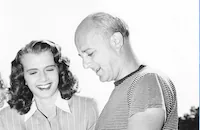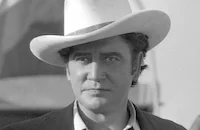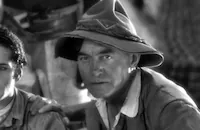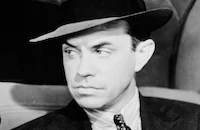Sky Giant

Brief Synopsis
Cast & Crew
Lew Landers
Richard Dix
Chester Morris
Joan Fontaine
Harry Carey
Paul Guilfoyle
Film Details
Technical Specs

Synopsis
When strict, demanding Colonel Cornelius Stockton is transferred to special duty at the Trans-World Air Line School of Aeronautics in Glendale, California, he maneuvers to have pilot W. R. "Stag" Cahill, a former Army Air Force captain, assigned as his assistant. To the colonel's dismay, his "wild" son Ken enrolls secretly in the school and soon becomes Stag's star student. In spite of the colonel's gruelling training schedule, Ken develops a friendly professional rivalry with Stag and also competes with him for Meg Lawrence, the cousin of a fellow pilot, "Fergie" Ferguson. After a night out with Meg, Ken is ordered by his father to perform a high-altitude test flight with Stag and, exhausted, faints in the thin air. Although Stag regains control of the plane in time to save the flight, he is reprimanded by the colonel for protecting his "cowardly" son. Unafraid, Stag defends Ken and tells Stockton that his overly zealous work schedules are ruining the pilots. Just as Stockton fires Stag and his son for insubordination, he receives a telephone call that two of his pilots have died during a test flight. Shamed, the colonel rehires Stag and Ken, who then becomes engaged to Meg. When Ken is assigned to join Stag and Fergie on a dangerous arctic mapping flight, however, a fearful Meg calls off the engagement. Before the flight, Stag tells Meg that if she marries him, he will stop flying after the arctic trip, and she weds him in a civil ceremony. As he flies north with Ken and Fergie, Stag announces his marriage to Ken, who grows morose with jealousy. Because of their poor maps, the pilots are forced to make an emergency landing in the arctic mountains, and the airplane crashes on takeoff. Ken and Stag carry an injured Fergie through a blizzard toward the coast, but after several slow days, Fergie sacrifices his life to the cold to save his friends. Near death, Stag collapses in the snow and is left behind by a still resentful Ken. Before long, however, Ken remembers the sacrifices that Stag made for him and returns to save him. Eventually, Ken and Stag locate a village, and when they arrive back in Glendale, they are heralded as aviation heroes. Stag, seeing that Meg still loves Ken, insists that their marriage be annulled, and Meg gracefully accepts Stag's final sacrifice.

Director

Lew Landers
Cast

Richard Dix

Chester Morris

Joan Fontaine

Harry Carey

Paul Guilfoyle
Robert Strange
Max Hoffman Jr.
Vicki Lester
James Bush
Edward Marr
Bernice Pilot
William Corson
Harry Campbell
Harold Goodwin
Donald Kerr
Gaylord Pendleton

Frances Gifford
Crew

Film Details
Technical Specs

Articles
Sky Giant
At this point in her career, Joan Fontaine, barely 21, was still playing roles that required little more than being the pretty young thing. It would be another two years before her breakthrough performances in two Alfred Hitchcock films, Rebecca (1940) and Suspicion (1941), which earned her the Academy Award many felt she should have won for the earlier Hitchcock role. But she works well with her two male leads as they vie for attention. In a few short years she would command enough clout to co-star with the likes of Cary Grant, Laurence Olivier and Charles Boyer. But her leading men in Sky Giant, while never among the top rank of Hollywood actors, were no amateurs. Richard Dix had been in films since early silent days and was a popular star at RKO from 1929 on. Although he never reached major stardom, he commanded the screen throughout his 30-year career in a series of hit pictures, many of them action programmers, and received an Academy Award nomination for his work in the western Cimarron (1931).
The younger Chester Morris made his screen debut at 16 in 1917 and worked steadily on stage, big screen, radio and television right up until he died in 1970 (in fact, he was appearing at Bucks County Playhouse in The Caine Mutiny Court-Martial at the time of his death). His greatest success came in a series of 13 movies in the 1940s in which he played the retired safecracker and amateur sleuth Boston Blackie. He received a Best Actor Oscar® nomination for Alibi (1929). Morris also occupies a special footnote in Hollywood history; in 1951 he was witness to the deathbed confession of his friend Roland West for the 1935 murder of actress Thelma Todd.
One other minor curiosity in the cast: the character of Edna, the commander's secretary, is played by Vicki Lester, which is the name of the character played by Janet Gaynor as the rising young actress in A Star Is Born (1937). The real-life Lester made her film debut that same year. It's not known whether her screen name was inspired by that of Gaynor's character in the hit picture. Unlike her fictional namesake, who became one of the biggest stars in the Hollywood depicted in William Wellman's picture, Lester never played more than a supporting part in a career that lasted just five years.
Much of Sky Pilot was filmed at the Grand Central Air Terminal in Glendale, CA. Reviewers at the time noted striking similarities between the climactic "Arctic mapping" flight made by the characters in this picture and the trans-world flight of millionaire aviator and film producer Howard Hughes, completed shortly before the film's preview screening. In fact, at a production meeting after the preview, it was suggested that the studio's advertising department use newsreel footage of Hughes's record-breaking flight in the movie's trailer. Hughes used a twin-engine Lockheed, one of three types of planes seen in this movie.
Director: Lew Landers
Producer: Robert Sisk
Screenplay: Lionel Houser, from his story "Ground Crew"
Cinematography: Nicholas Musuraca
Editing: Harry Marker
Art Direction: Van Nest Polglase
Original Music: Roy Webb (uncredited)
Cast: Richard Dix ("Stag" Cahill), Chester Morris (Ken Stockton), Joan Fontaine (Meg Lawrence), Harry Carey (Col. Stockton), Paul Guilfoyle (Ferguson).
BW-81m.
by Rob Nixon

Sky Giant
Quotes
Trivia
Reviewers noted that the arctic mapping flight in the movie was very similar to 'Hughes, Howard' ' trans-world flight, which he completed shortly before the preview screening.
Lockheed 12, Ryan St and Stinson Reliant airplanes were used in the film.
Notes
The working titles of this film were Ground Crew and Northern Flight. In an onscreen prologue, the filmmakers dedicate the film to the aviation pioneers of America. According to a Hollywood Reporter news item, scenes from the movie were shot at Grand Central Air Terminal in Glendale, CA. Reviewers commented on the similarity between the "arctic mapping flight" that was featured in the film and millionaire aviator Howard Hughes's trans-world flight, which was completed shortly before the film's preview screening. According to Motion Picture Herald, during a production meeting that took place after the film's California preview, it was suggested that the RKO advertising department use newsreel footage of Hughes's record-breaking flight as part of the movie's trailer. Hughes made his trip in a twin-engined Lockheed in three days and nineteen hours. Modern sources note that Lockheed 12, Ryan ST and Stinson Reliant airplanes were used in the production.














